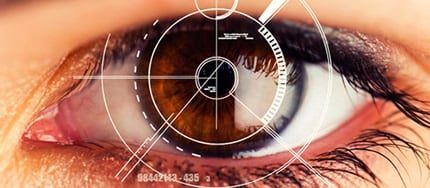Blurry Vision Causes & Treatment
in Stockton, Modesto, & Manteca, CA
Astigmatism

Astigmatism
Astigmatism, unlike normal vision, occurs when the cornea is shaped like a football (more curved in one direction than the other) and often occurs in combination with myopia (nearsightedness) and hyperopia (farsightedness). This causes light to focus in more than one point on the retina, resulting in blurry and distorted vision.
Farsightedness
Hyperopia (farsightedness), unlike normal vision, occurs when the cornea is too flat in relation to the length of the eye. This causes light to focus at a point beyond the retina, resulting in blurry close vision and occasionally blurry distance vision as well. Usually this condition is undetected until later in life because the young eye is able to compensate for the hyperopia by contracting the internal lens of the eye.
Nearsightedness
Nearsightedness
Myopia (nearsightedness), unlike normal vision, occurs when the cornea is too curved or the eye is too long. This causes light to focus in front of the retina, resulting in blurry distance vision.
Myopia is a very common condition that affects nearly 30 percent of the U.S. population. It normally starts to appear between the ages of eight and 12 years old, and almost always before the age of 20. As the body grows, the condition often worsens. It typically stabilizes in adulthood.
Presbyopia
Presbyopia is a vision condition in which the lens loses its flexibility, making it difficult to focus on close objects. During the early and middle years of life, the crystalline lens of the eye has the ability to focus both near and distant images by getting thicker for near objects and thinner for distant objects. When this ability is lost, presbyopia results.
FAQ
What Is Blurry Vision?
Although it may sound simple, blurry vision is a complex issue that can be caused by a number of things. On its own, blurry vision is when your eyesight is not as crisp or clear as it was. You may have to squint to bring certain things into focus. Blurry vision usually becomes worse over time, but it is possible for some people to have it periodically.
Below is a list of conditions that blurry vision can point to:
- Diabetes
- Migraine headaches
- Stroke
- Having a head injury
- Having low blood sugar
- Multiple sclerosis
- Psoriasis
- Pre-eclampsia
- Dry eye syndrome
- Cataracts
- Glaucoma
- Eye infection
- Diabetic retinopathy
- Astigmatism
- Presbyopia
In order to know for sure what the cause of your blurry vision is, you will need to have a comprehensive eye exam performed.
Does Blurry Vision Affect Both Eyes?
Both eyes can be affected, but there are some cases where blurry vision only affects one eye. It really depends on what is causing your blurry vision. For example, eye strain is a common reason why your vision may be blurry, and it can only affect one eye while the other is perfectly fine.
How Is Blurry Vision Treated?
The treatment for blurry vision varies from person to person. Sometimes, eye drops, or a specific medicine can tackle the problem. Other cases may require more intensive treatment, such as laser eye surgery. If those do not solve the problem, wearing contact lenses or a pair of glasses can help you see better and take the strain off your eyes.
Testimonials:
- “This is the best place to go to have your vision corrected….very friendly….Dr. Tittler is the best !” – B.W.
- “The whole staff were so nice. I was accommodated right away. Dr. Girn was so nice as well and very professional. He answered my questions clearly. Will definitely recommend this place to other people” – L.A.
Schedule an Eye Exam
If you are suffering from blurry vision, the Central Valley Eye Medical Group is here to help! We operate in Stockton, Manteca, and Modesto areas in California. Contact us at 1-800-244-9907 to schedule your eye exam with us today.











